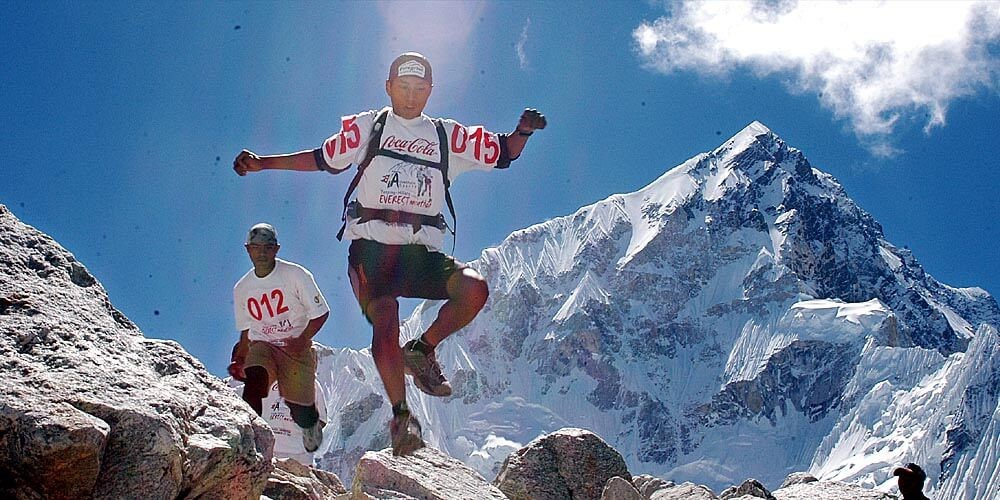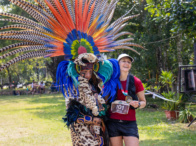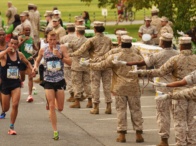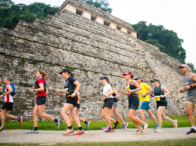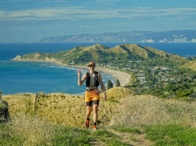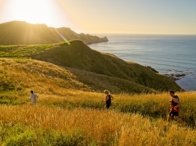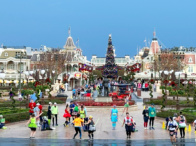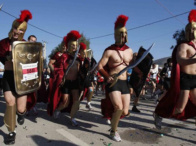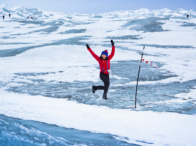Tenzing Hillary Everest Marathon represents a tribute to the first successful summit of Mount Everest by Tenzing Norgay and Sir Edmund Hillary. This annual event has grown to attract runners globally, symbolising adventure and personal achievement as it is the world’s highest marathon!
Participants not only follow in the footsteps of legendary mountaineers but also experience the rich culture and stunning vistas of the Himalayas.
Here’s a detailed account of the Everest Marathon route and what participants can expect.
Everest Marathon Route
Starting Point: Everest Base Camp
With the start of this race taking place at Everest Base Camp (EBC), you’ll need to book your race through an approved travel partner to help guide you to the starting point.
Travelling Fit is proud to be the official Australian sales representative for the Tenzing Hillary Everest Marathon and our Everest Marathon travel packages offer 3 different trekking options depending on which route you wish to take.
- Lodge Trek
- Gokyo Valley Trek
- Island Peak Summit Trek:
These treks take 12-14 days to complete depending on your route and include internal flights, guides, porters, meals etc..
Once the group arrives at Everest Base Camp, we’ll camp another 2 nights to acclimatise before taking on the race.
Descent to Gorak Shep and Lobuche
Approximately about 4.6km from EBC, the route descends to Gorak Shep, a frozen lake bed covered with sand, offering a slight respite but still situated 5,000 metres above sea level.
From here, the trail then leads to Lobuche, a small settlement providing stunning views of Pumori and other Himalayan giants.
This segment tests runners with its mix of rocky terrain and glacial moraine.
Upon completing this section, runners will have run just under 10km at this race stage.
The Khumbu Glacier: Thukla
At around the 12.3km mark with an altitude of 4,612m, runners will start crossing the Khumbu Glacier.
This section of the race is a highlight for many, presenting a surreal landscape of ice and snow.
Caution is a must, as the terrain here is unpredictable and requires careful navigation.
Thukla to Dingboche
Descending from Thukla, the route to Dingboche reveals breathtaking vistas of Ama Dablam.
This part allows for a brief rest as runners enjoy a relatively easier path, crossing lush pastures.
As runners approach Dingboche (at 17.3km point), they are greeted by the rich culture of the Sherpa people.
The altitude of Dingbouche is 4,359m, approximately 1,000m lower than the EBC starting point.
Dingboche to Bibre Loop
From Dingboche, the journey takes a steep turn upwards towards the challenging Bibre Loop.
Here, athletes test their grit against sharp ascents, rewarded with panoramic views at the loop’s peak.
Bibre Loop to Pangboche
Descending from the loop, the path to Pangboche offers a momentary break with its smoother, downhill terrain.
Pangboche (27.5km) welcomes runners with its traditional Sherpa culture and warmth.
Pangboche to Tengboche
This stretch of the race is predominantly downhill but includes a steep ascent as runners close in on Tengboche, home to the famous monastery.
At 32.6km into the race, participant’s efforts are rewarded with one of the route’s most spectacular backdrops.
Tengboche is also home to the famous monastery and offers a spiritual reprieve, allowing runners to pause and reflect amidst the serenity of this sacred site.
The route through these villages introduces participants to the vibrant culture that thrives in the shadow of Everest.
Tengboche to Laublsasa
From Tengboche, participants head towards Laublsasa (36.1km point of the race), encountering mixed terrain that tests their adaptability.
This is a steep descent with runners experiencing over 400m of elevation loss during this 3.5km stretch.
Known for its rhododendron forests, this section also adds a splash of colour to the challenge.
Laublsasa to Kyangjuma
As runners leave Laublsasa, the path to Kyangjuma (37.6km) they tackle the last steep incline of the race.
While this section will challenge the fittest of participants, reaching the picturesque hamlet of Kyangjuma serves as a sign of progress, marking the nearing of the marathon’s end.
Kyangjuma to Namche
The final leg from Kyangjuma to Namche Bazaar is a triumphant return to civilisation.
Runners push through fatigue, cheered on by the vibrant spirit of Namche, as they cross the finish line in the heart of the Sherpa capital.
This concludes the total 42km of the full marathon course of the Tenzing Hilary Everest Marathon.
Everest Marathon Route Map
Source: Alltrails
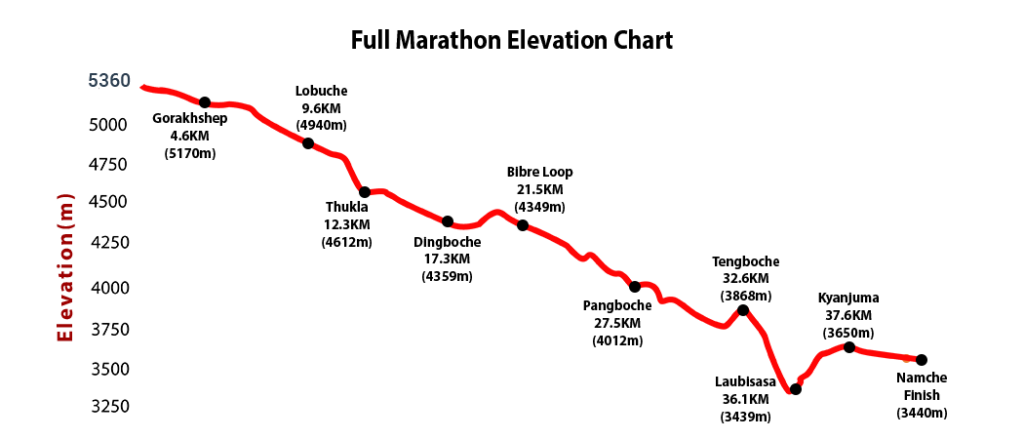
Everest Marathon Checkpoints
Throughout the race, there are a series of checkpoints that are crucial for runners’ safety and well-being.
Starting from Everest Base Camp, the marathon route winds down to Namche Bazaar, crossing various landscapes.
The first checkpoint is at Gorak Shep, offering medical checks and hydration.
Lobuche, the next station, serves as a spot for energy replenishment.
Dingboche and Tengboche checkpoints follow, providing medical aid and moral support.
The final push towards Namche includes Phunki Tenga, ensuring runners are ready for the last leg.
These checkpoints are lifelines, equipped with essentials and emergency support, guiding participants through their challenging journey.
Course Challenges
- High Altitude: The entire race is run at high altitudes, starting at 5,364 meters and descending to 3,446 meters. This places a significant demand on the body, even for the fittest runners.
- Rough Terrain: The trails are rocky, uneven, and often narrow, requiring careful navigation and sturdy footwear.
- Weather Conditions: The weather can be unpredictable, with the potential for cold temperatures, strong winds, and even snow at higher altitudes.
Want to secure a great deal on race entry and accommodation?
Are you ready to take on one of the most exhilarating and challenging marathons in the world?
Travelling Fit is the official Australian sales representative for this iconic event, has been helping adventurers from across the world conquer this race for over 16 years.
We offer exclusive packages that cater to every aspect of your Everest Marathon experience, ensuring a smooth preparation for the big day. Choose between:
- 19 days / 18 nights – Lodge Trek + race event
- 21 days / 20 nights – Gokyo Valley Trek + race event
- 22 days / 21 nights – Island Peak Summit + race event
All packages include:
- Guaranteed race entry (Runners only)
- Return airport Transfers in Kathmandu
- 4 Nights of hotel accommodation in Kathmandu (2 pre and 2 post-trek)
- 12 Nights lodging during the trek
- 2 Nights camping at Everest Base Camp before race day
- Half-day sightseeing tour in Kathmandu
- Return flights between Kathmandu or Ramechap and Lukla
- All meals are included whilst on the trek
- Celebration Dinner Party and awards in Kathmandu on 02 June
- Certified Guides
- Trekking permits and National Park entrance fees
- Porters to carry luggage during the trek (max. 15kg per person)
- Personalised Travelling Fit Running Top
- Invite to Travelling Fit’s Closed Facebook Group
We also offer these packages for the Tenzing Hillary Everest Half Marathon and Ultra Marathon.
Check out our event pages to learn more or contact us today to speak with a member of our friendly staff!

